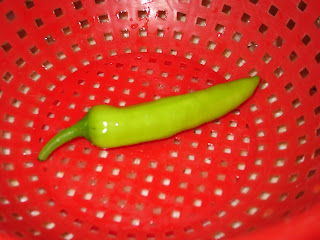Winter is coming. The cooler evenings and the brisk mornings bring a tear to my eye. The corn stalks are turning brown and the green bean leaves are drying out. The victory garden is slowly coming to slow halt this season. Not all is bad though. There is always time to cook and eat the fruits of our labor and that is what happened during the 2011 Harvest Feast.
This year I was able to share the victory garden's culinary delights with friends as well as family. Now you may be wondering, "what's on the menu?" I tried to incorporate as much of the victory garden into each recipe without tarnishing the integrity of each dish. Remembering that I only have a garden, and not a farm, to contribute to the meal I found myself adding in a few key ingredients here and there to help bring flavor and enjoyment to each dish. This is what we munched on during this year's harvest feast:
 |
| stuffed peppers |
Elote (aka Horn corn, Mexican corn on the cob) - steamed/BBQ/boiled corn on the cob, covered in mayo and lime, rolled in cotija cheese and sprinkled with hot sauce
Stuffed bell peppers - red and green bell peppers filled with stuffing and barbequed for 20 minutes; stuffing is made with white rice, portabella mushrooms, chives, and pepperoncini peppers
Yellow neck squash bread - our large harvest of yellow neck squash this year has allowed me to experiment with bread. I love to make zucchini bread and found yellow neck squash is a yummier alternative when zucchini is not available. I personally prefer the yellow squash over the green zucchini any day.
 |
| veggie casserole |
Salad - this dish utilized the lettuce, cucumber, basil and tomatoes from the garden
Dill pickles, salsa & chips - pickles and salsa were canned during the 2010 season
Spiced Ginger and Mom's pickled cucumbers - see my July 29, 2011 blog for recipe
Veggie casserole - egg plant, yellow neck squash, zucchini, green beans, chives, cheese, mushroom soup, and topped with bread crumbs
Veggie and animal burgers - Boca spicy chicken burgers and beef patties on whole wheat buns; cheese, lettuce, tomatoes and onion were available to add to each burger
Victory Garden Alert! Victory Garden Alert!
The garden has produced the largest zucchini the garden has ever grown. The zucchini measures 20 inches in length. Large zucchini, like this one, is great for stuffing and baking.


















































